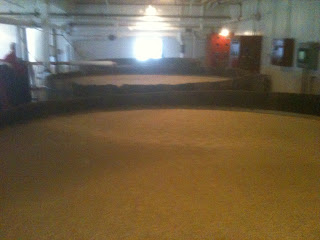Making the Mark
The Making of Great Kentucky Bourbon
As I mentioned in my previous post, I had visited Louisville, Kentucky to visit my family. While I always have a good time visiting them, I would at times become a bit anxious to do something besides hanging around my mothers’ house. I decided before that I left Providence that I was going to visit a distillery. Kentucky has what is known as “The Bourbon Trail”. http://kybourbontrail.com/index.php I looked up some of the distilleries that are part of the trail, and look at the ones that were the closest to Louisville. After examining many distilleries, I decided to make a day trip out to the Maker’s Mark® Distillery. Why is bourbon making primarily located in the State of Kentucky? Farmers fleeing President George Washington’s highly unpopular Whisky Tax, were in search of pure, iron-free water, and found it in the frontier state of Kentucky, and began distilling what came to be known the world over as bourbon. One of these farmers was Robert Samuels, great-great-great-grandfather of Bill Samuels, Sr., the creator of Maker’s Mark®. A family birthright was established.
 |
| The Copper Stills |
Maker’s Mark® is bourbon that is handcrafted in Loretto, Kentucky, that portrays the sweet, non-bitter flavor Bill Samuels Sr. was looking for when he reinvented modern bourbon in the 1950s. Thanks to my GPS unit, I had a harrowing drive through the backwoods of Kentucky, and I finally pulled up to the distillery, through the delivery entrance. The distillery is located on beautiful acreage, covered in huge maple and hickory trees. As a drove up the driveway, I noticed a small building to the right of me that seemed to be out of place. It looked quite old and I was curious what it could possibly be. I later learned that it was the oldest package store in the nation!
 |
| The Old Package Store |
What makes Marker’s Mark® unusual in the world of bourbon is that no rye (which is commonly used) is NOT used in the mash. Corn is mixed with red wheat and malted barley grain. Maker’s Mark® is known as a small batch bourbon. This means that the bourbon is produced or distilled in small quantities (1,000 gallons) or 20 barrels from a batch of 200 bushels of grain.
 |
| The Main Entrance of the Distillery |
So without further adieu, let’s look at the Maker’s Mark® Distillery. Oh and just so you know, Marker's Mark® uses the Scottish spelling of "Whiskey" which is "Whisky".
 | |||||||||||
| The Mash Vats |
Once I entered through the front doors of the main entrance, I was whisked off to the vat room, where the mash is stored for eight days in vats to ferment. The vats are huge and stand 12 feet tall. A yeasty odor permeated the room as the vats filled with mash, bubbled and popped with fermenting activity. The picture above shows "new" mash with small bubbles, while the picture below is mash that ready for filtering, distillation, and barrel filling. Note the frothy foam and bubbles on the top of this vat.
My tour guide told me to dip my finger into the "mature" vat and taste the mash. I did so, and it had an unusual taste of popcorn! The guide told me that this is what is known as the "Moonshine" that most people associate with the Appalachian Mountains.
The mash is then drained from the vat via a network of pipes to the filtering room and distillation room. Once filtered, charred oak barrels (which are built on site) are filled with the clear liquid and transported to the aging warehouse. Each barrel is hand rotated to keep a consistency of aging.
 |
| Double Filtering the Mash |
 | |||||
| Barrel Warehouse- Maker's Mark® Rickhouse by twofishblu, via Flickr |
Once the mash has aged to perfection, it is then taken to the bottling plant. I was surprised at how low-key the operation was. The reason? Every bottle regardless of size is labeled (by labels that are printed and cut on site), filled and then hand dipped in Marker's Mark® trademark red wax. Below is a video that I shot with my iPhone®, which shows the entire bottling production line. The entire line is manned by only twelve people which to me was amazing. All the employees rotate each position so that the four wax "dippers" are only subject to the hot temperatures of the wax dipping vats for 30 minutes at a time.
The production Line

























